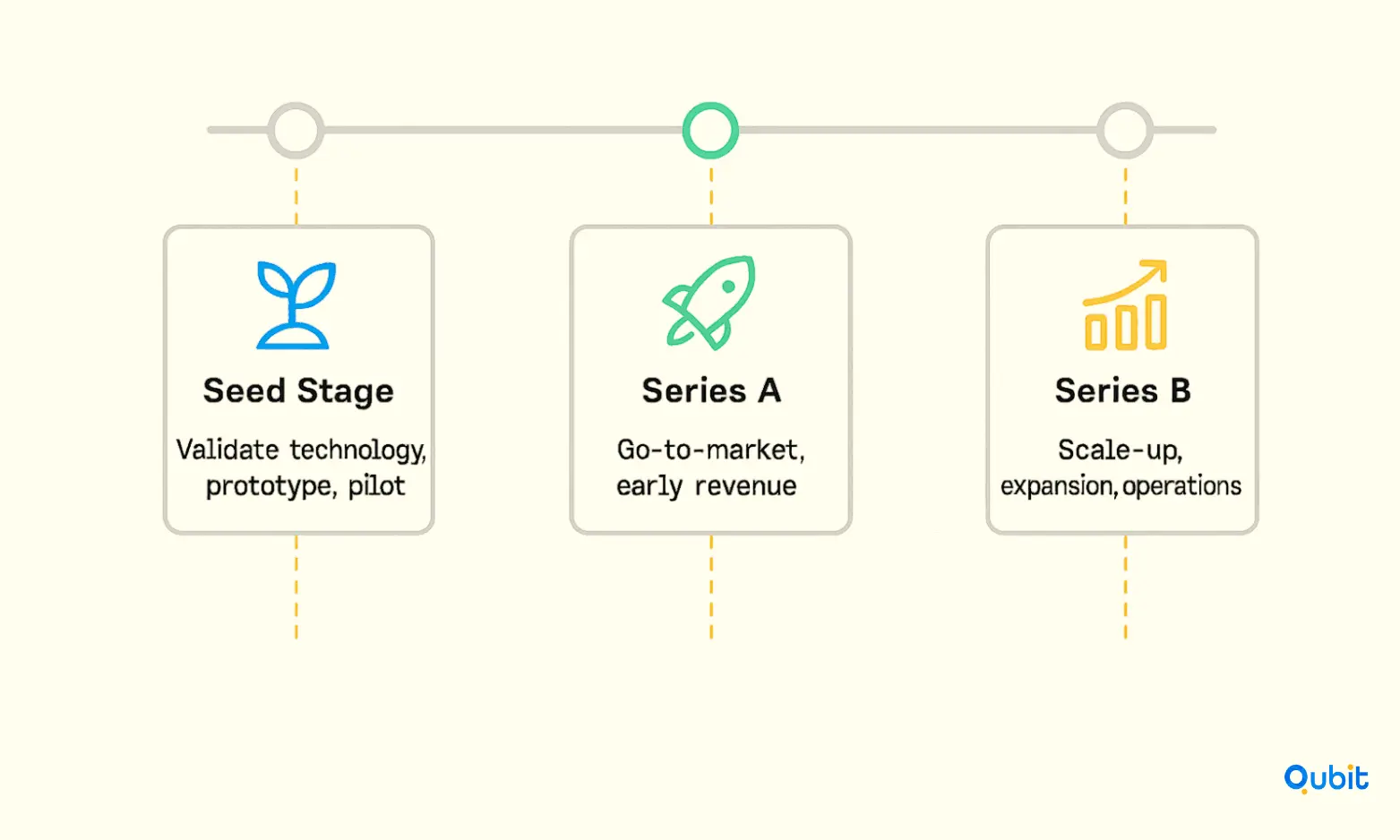The AgriTech sector is at the heart of the world’s most urgent challenges: food security, climate resilience, and sustainable resource management. As digital transformation, biotechnology, and data-driven agriculture reshape the landscape, AgriTech startups are attracting unprecedented investor attention. Yet, moving from seed funding and early pilots to scaling through Series A and B is a leap that requires more than vision, it demands operational discipline, market traction, and a compelling growth story.
This guide will walk AgriTech founders through the strategic, financial, and operational milestones required to secure Series A and B funding in 2025. We’ll cover what investors expect, how to build a data-driven fundraising narrative, the importance of team and governance, and how to leverage alternative and non-dilutive funding sources.
Understanding the Funding Journey: From Seed to Series B

The Funding Ladder in AgriTech
- Seed Stage: Focused on validating the core technology or solution, building a prototype, and running initial pilots. Funding typically comes from angels, accelerators, and seed funds.
- Series A: The “go-to-market” round. Investors expect proof of product-market fit, early revenue, and a scalable business model.
- Series B: The “scale-up” round. Here, the focus shifts to rapid growth, international expansion, and operational excellence.
The transition from seed to Series A and B is not just about raising more money—it’s about proving you can turn innovation into impact at scale. Start with growth capital strategies for agri/foodtech to line up the right mix of equity, debt, and non-dilutive support.
What Series A Investors Expect in AgriTech
1. Demonstrated Product-Market Fit
By Series A, AgriTech startups must show that their solution solves a real pain point for a clearly defined customer segment. This means:
- Consistent Revenue: Most Series A investors look for $1M+ in annual recurring revenue (ARR) or strong, repeatable sales from pilot customers.
- Customer Validation: Letters of intent, signed contracts, and case studies from early adopters (ideally enterprise, co-ops, or institutional buyers).
- Clear Use Case: Evidence that your technology delivers measurable value, higher yields, reduced water use, lower input costs, or improved traceability.
2. Scalable Go-to-Market Strategy
Investors want to see a repeatable, cost-effective sales process. Key elements include:
- Defined Sales Funnel: Metrics on lead generation, conversion rates, and sales cycle length.
- Channel Partnerships: Collaborations with agri-input companies, distributors, or government programs to accelerate adoption.
- Customer Segmentation: A clear understanding of target markets (e.g., smallholders vs. large commercial farms, specific geographies or crops).
3. Robust Unit Economics
- LTV:CAC Ratio: Lifetime value (LTV) to customer acquisition cost (CAC) of at least 3:1 is a common benchmark.
- Gross Margins: Investors expect to see improving margins as you scale, especially for SaaS or data-driven models.
- Churn and Retention: Low customer churn and strong retention signal product stickiness.
4. Team Depth and Governance
- Experienced Leadership: Founders with sector expertise and a track record of execution.
- Professionalized Team: Key hires in sales, operations, and product management.
- Board and Advisors: A governance structure that includes independent directors and industry advisors.
For more on early-stage preparation, see our early-stage funding guide for AgriTech & FoodTech startups.
Preparing for Series A: The Tactical Checklist
1. Build a Data Room
A well-organized data room is essential for due diligence. It should include:
- Financial statements and projections
- Customer contracts and LOIs
- IP documentation and patents
- Product roadmap and technical documentation
- Cap table and legal documents
2. Sharpen Your Metrics
Investors will scrutinize your KPIs. Be ready to present:
- Monthly and annual revenue growth
- Customer acquisition and retention rates
- Gross margin trends
- Sales pipeline and forecast accuracy
3. Refine Your Story
Your pitch must clearly articulate:
- The problem you solve and why it matters now
- How your solution is differentiated (technology, business model, impact)
- The size of the addressable market (TAM/SAM/SOM)
- Traction to date and milestones ahead
4. Validate Your Business Model
- Show evidence that your pricing, distribution, and support models are scalable.
- Highlight any recurring or subscription revenue streams.
- Demonstrate that you can serve multiple customer segments or geographies.
5. Secure Strategic Partnerships
- Partnerships with agri-input companies, food processors, or government agencies can accelerate adoption and de-risk your business.
- Document any joint pilots, co-development agreements, or distribution deals.
Series B: Scaling Up and Professionalizing Operations
1. Proving Scale and Market Leadership
Series B investors expect to see:
- $3M–$10M+ in ARR (or equivalent revenue for non-SaaS models)
- Expansion into new markets or verticals
- Strong brand recognition and customer advocacy
- Repeatable, data-driven sales and onboarding processes
2. Operational Excellence
- Professionalized Finance and HR: Robust financial controls, forecasting, and compliance systems.
- Supply Chain Management: For hardware or input-intensive AgriTech, demonstrate reliable sourcing, manufacturing, and distribution.
- Customer Success: Dedicated teams to drive adoption, reduce churn, and upsell.
3. Product and Technology Roadmap
- Major Product Launches: Series B often funds the rollout of new product lines or platform features.
- Internationalization: Expansion into new countries or regions, with localization and regulatory compliance.
- R&D Investment: Continued innovation to stay ahead of competitors.
4. Strategic Partnerships and Ecosystem Building
- Corporate Partnerships: Collaborations with agribusinesses, retailers, or equipment manufacturers.
- Government and NGO Programs: Participation in public-private partnerships to drive adoption at scale.
- Industry Alliances: Membership in AgriTech consortia or standards bodies.
5. Third-Party Validation
- Case Studies and Impact Data: Quantitative evidence of yield improvement, cost savings, or environmental benefits.
- Awards and Certifications: Recognition from industry bodies or government agencies.
- Media and Analyst Coverage: Positive press and thought leadership.
Building a World-Class Team and Board
1. Leadership for Growth
- C-Suite Hires: Bring in experienced executives for COO, CFO, and Chief Commercial Officer roles.
- Diversity: Build a team with diverse backgrounds, including agronomy, technology, and business development.
2. Board and Governance
- Independent Directors: Add board members with experience in scaling AgriTech or related sectors.
- Advisory Board: Engage sector experts, farmers, and policy advisors for guidance and credibility.
3. Culture and Values
- Mission Alignment: Attract talent and investors who are passionate about agriculture, sustainability, and impact.
- Professional Development: Invest in training and upskilling to retain top talent.
Financial Strategy: Managing Burn, Runway, and Capital Efficiency
1. Burn Rate and Runway
- 18–24 Months Runway: Raise enough capital to reach key milestones before the next round.
- Scenario Planning: Model best-case, base-case, and worst-case scenarios for revenue and expenses.
2. Capital Efficiency
- Lean Operations: Prioritize spending on activities that drive revenue and product development.
- Outsourcing: Use contractors or partners for non-core functions.
- Milestone-Based Spending: Tie major expenditures to achieving specific growth or product milestones.
3. Alternative and Non-Dilutive Funding
- Venture Debt: Use debt to extend runway without diluting equity. For more, see debt financing options for AgriTech scale-ups.
- Government Grants: Leverage national and regional programs for R&D, sustainability, and rural innovation.
- Revenue-Based Financing: For SaaS or recurring revenue models, consider non-dilutive capital tied to future cash flows.
The Importance of Strategic Partnerships
1. Corporate Partnerships
- Co-Development: Joint product development with large agribusinesses or equipment manufacturers.
- Distribution: Leverage partners’ sales networks to reach new customers.
- Data Sharing: Collaborate on data-driven insights for supply chain optimization or sustainability.
For more on this topic, visit strategic corporate partnerships for FoodTech funding.
2. Government and NGO Programs
- Pilot Projects: Participate in government-funded pilots to validate your solution at scale.
- Subsidies and Incentives: Tap into programs supporting climate-smart agriculture, digital inclusion, or rural development.
3. Incubators and Accelerators
- Mentorship and Networks: Access to sector experts, investors, and corporate partners.
- Follow-On Funding: Many programs offer bridge funding or introductions to Series A/B investors.
Building a Data-Driven Fundraising Narrative
1. Market Sizing and Competitive Analysis
- TAM/SAM/SOM: Quantify your total addressable, serviceable, and obtainable market.
- Competitor Mapping: Show how your solution is differentiated and defensible.
2. Impact Metrics
- Yield Improvement: Quantify how your solution increases productivity.
- Resource Efficiency: Demonstrate reductions in water, fertilizer, or pesticide use.
- Climate Impact: Measure carbon sequestration, emissions reduction, or soil health improvements.
3. Customer Stories
- Case Studies: Highlight real-world results from pilot customers.
- Testimonials: Collect endorsements from farmers, co-ops, or enterprise clients.
4. Financial Projections
- Revenue Forecasts: Show how you’ll scale from current ARR to $10M+ in the next 2–3 years.
- Expense Breakdown: Detail how capital will be allocated (R&D, sales, operations).
- Milestones: Tie funding needs to specific growth or product milestones.
Common Pitfalls and How to Avoid Them
- Underestimating Sales Cycles: AgriTech sales often take longer due to seasonality, procurement cycles, and regulatory approvals. Build this into your forecasts.
- Ignoring Regulatory Hurdles: Ensure your product meets local and international standards for safety, data, and environmental impact.
- Weak Governance: Investors expect professional boards and clear decision-making processes.
- Overpromising on Impact: Back up your claims with data and third-party validation.
- Lack of Focus: Don’t try to serve every customer segment at once; focus on your best-fit market and expand from there.
Alternative and Non-Dilutive Funding Sources
1. Venture Debt
- Pros: Extends runway without diluting ownership.
- Cons: Requires predictable cash flow and strong financial controls.
2. Government Grants
- Pros: Non-dilutive, supports innovation and impact.
- Cons: Competitive, time-consuming application process.
3. Revenue-Based Financing
- Pros: Flexible, aligns repayments with revenue.
- Cons: Best for SaaS or recurring revenue models.
Case Studies: AgriTech Startups Scaling Through Series A & B
1. CropIn (India)
- Series A: Raised $8M to expand its AI-powered farm management platform.
- Series B: Secured $20M for international expansion, product development, and scaling partnerships with agribusinesses and governments.
2. Apeel Sciences (US)
- Series A: $6M to commercialize its plant-based food preservation technology.
- Series B: $33M to scale manufacturing, enter new markets, and deepen R&D.
3. Taranis (Israel)
- Series A: $7.5M for its precision agriculture platform.
- Series B: $20M+ to enhance AI capabilities, expand into Latin America, and build out its sales team.
4. DeHaat (India)
- Series A: $12M to grow its digital marketplace for farmers.
- Series B: $30M to scale logistics, expand into new regions, and launch new services.
Conclusion
Securing Series A and B funding in AgriTech is a rigorous, data-driven process that rewards startups able to combine innovation with operational excellence and impact. By focusing on scalable growth, robust governance, and strategic partnerships, founders can unlock the capital needed to transform agriculture and food systems for a sustainable future.
If you're ready to propel your startup to new growth levels, we invite you to explore our Fundraising Assistance service. Contact us today to get started and turn your vision into reality.
Key Takeaways
- Series A is about proving product-market fit, scalable sales, and robust unit economics.
- Series B is about demonstrating rapid growth, operational excellence, and market leadership.
- Build a strong team, professionalize governance, and invest in data-driven decision-making.
- Leverage strategic partnerships, government programs, and alternative funding to accelerate growth.
- Prepare a compelling, metrics-driven fundraising narrative tailored to investor expectations.
Frequently asked Questions
What ARR do AgriTech startups need for Series A and B?
Series A investors typically look for $1M+ ARR, while Series B investors expect $3M–$10M+ and evidence of rapid scaling.





